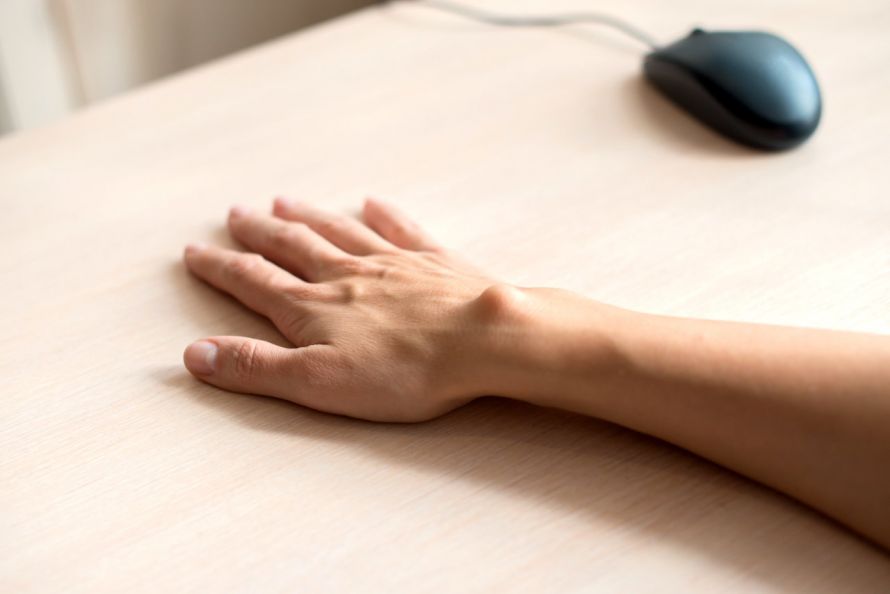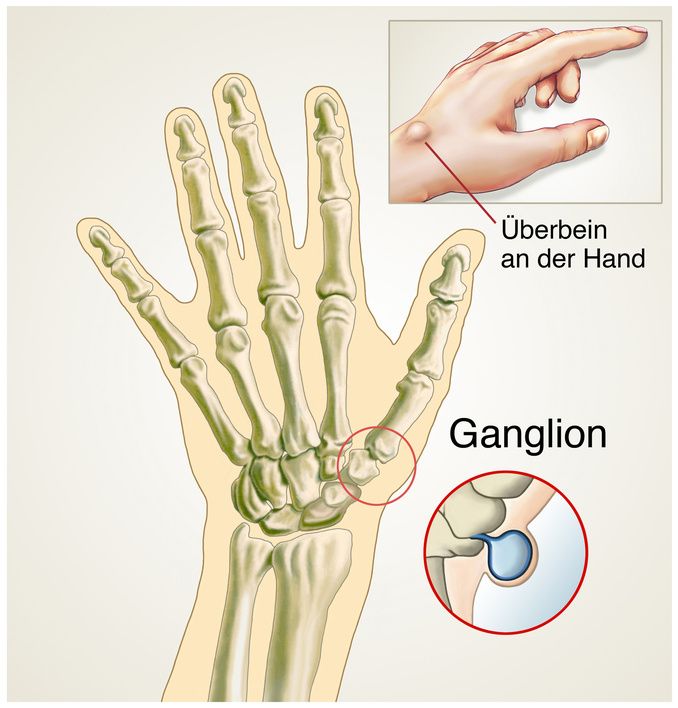The ganglion (ICD code: M67.4) is commonly known as a ganglion. However, this term is misleading, because a ganglion is not additional bone material that has grown.
A ganglion is a cyst that forms on a joint or a tendon. A cyst is a cavity filled with joint fluid (synovial fluid or synovia).
This synovial cyst is basically benign – so there is no risk of the ganglion degenerating. The ganglion is therefore not a tumour.
Seen from the outside, a ganglion resembles a bump that is a few millimetres to centimetres in size. A ganglion can reach the size of a pea or cherry.
Inside, i.e. at the place of origin of the ganglion under the skin, the ganglion consists of a capsular stalk and a capsular bulge.

Ganglion on the wrist © Yulia | AdobeStock
Ganglia occur most frequently
- on the outside of the hand,
- on the wrist or
- on a finger.
In about two thirds of all cases, it is a wrist ganglion.
Also possible, but much rarer, are ganglia
Furthermore, physicians distinguish between
- arthrogenic ganglia affecting the joint, and
- tendinogenic ganglia arising on a tendon sheath (tendon sheath ganglion).
In rare cases, the ganglion forms within a bone. In this case, doctors speak of an intrabony ganglion.

A ganglion often develops on the hand. © Henrie / Fotolia
The formation of a ganglion can have individual reasons. Usually, such a cyst develops due to an incorrect load on the joint or weak connective tissue.
With a connective tissue weakness tears and bulges can form more easily in the tendon sheath or joint capsule. Synovial fluid (joint fluid) then leaks out here and collects in the resulting expansion. The fluid therefore cannot drain back and a ganglion develops.
People of all ages can get a ganglion. Women seem to be affected more often because of their often loose connective tissue.
There are certain risk factors for a ganglion. These include, for example:
- repeated injuries to the ligaments/tendons
- disturbed mechanics of the joint/tendon
- arthrosis, rheumatism, gout
- Incorrect loading or overloading
Uniform movements can promote the formation of a ganglion. Therefore, some sports, certain hobbies or manual work are particularly predestined for the formation of a ganglion.
Prevention is possible through a healthy lifestyle. This helps to avoid pathological changes in the musculoskeletal system from the outset. This includes healthy movement patterns and a sensible balance between rest and exertion.
Monotonous or one-sided stressful activities can favour the development of a ganglion, especially at the wrist.
In many cases, a ganglion does not cause any symptoms. Then the ganglion is mainly a cosmetically perceived blemish.
Which symptoms occur depends primarily on the affected area and the location of the ganglion.
A ganglion that exerts pressure on the tendons can impair the mobility of joints and muscles Muscles severely affect the mobility of joints and muscles. The ganglion can also squeeze nerve tracts and blood vessels. In this case, those affected suffer from
- Discomfort,
- Numbness or
- Pain that can radiate from the wrist to the entire arm, for example.
A ganglion can already be seen with the naked eye as a small bump. These other signs are typical of a ganglion:
- A ganglion is always plump and feels like a firm rubber ball that yields to light pressure and keeps its shape.
- It cannot be moved at all or only slightly because it is directly connected to the affected tendon or joint.
- In addition, the region is neither reddened nor heated, as a ganglion is not an inflammatory process.
If you experience these symptoms, especially neurological deficits, you should seek medical attention. Talk to your family doctor or go directly to an Orthopaedist. It is advisable to prefer a specialist – for example, a hand surgeon if the ganglion is on the hand.
A detailed medical history and subsequent palpation of the affected area are usually sufficient for diagnosis. The doctor will ask you,
- how long the swelling has existed,
- whether it causes pain or impairment; and
- whether you have recently suffered an injury.
If you have noticed any other ulcers on your body, you should also point them out to the doctor.
This is followed by an examination for
By means of so-called transillumination, the doctor can check whether it is a swelling filled with fluid. With transillumination, the supra-leg is illuminated from the side.
Ultrasound and MRI are only used in exceptional cases – mostly to rule out other diseases. For this purpose, a pathological examination of the fluid in the laboratory is also possible.
If the ganglion is accompanied by no complaints, no treatment is actually necessary. However, many sufferers perceive the cyst as a visual flaw.
Conservative treatment
In principle, a ganglion can regress on its own, i.e. spontaneously. So it may be sufficient to observe the ganglion and have some patience. After about three months, the ganglion may have receded.
Under no circumstances should you work on the ganglion with force or even cause it to burst, as it can otherwise become inflamed.
You can support the conservative treatment with ointments and rubs. Horse ointment or arnica creams, for example, have proven effective. Since the ganglion does not arise from inflammation, you do not need to apply any special anti-inflammatory agents.
Also
- immobilisation with bandages,
- physiotherapy and
- targeted massaging
can help to reduce the size of the ganglion or make it disappear completely.
When conservative treatment is not enough: Removal and puncture of ganglia
If a ganglion does not regress on its own, there are two treatment options:
- Aspiration or puncture
- Surgery
Aspiration involves puncturing the ganglion with a fine needle. The removed fluid significantly reduces the size of the ganglion. In addition, the doctor can have it examined and confirm the diagnosis.
The doctor can then inject a substance (for example ethanol or a corticosteroid) into the cavity created. To do this, the doctor electrically scleroses the surrounding tissue in parallel. This treatment usually has to be repeated several times to achieve lasting success.
If the ganglion causes severe pain or other impairments, or if the patient suffers emotionally from the ganglion, surgical removal can be considered. This mostly outpatient procedure is performed either classically through a larger skin incision or minimally invasively.
Puncture and surgery: How effective is the treatment of a ganglion?
The chances of success are very good, provided the ganglion can be removed without leaving any residue.
However, complications are to be expected, especially in the case of surgery with a large skin incision, for example
- Wound healing disorders,
- Nerve injuries or
- Vascular bleeding.
Aspiration, on the other hand, only causes problems in two percent of all cases.
Whether aspiration or surgery: Even after successful treatment of the ganglion, it can reoccur in the same place. If the ganglion was caused by monotonous movement patterns and incorrect stresses, the best prevention is to avoid these overloads.
A ganglion is harmless – nevertheless, it is advisable to consult a doctor if you suspect a ganglion. The doctor can make a reliable diagnosis and, if necessary, initiate appropriate treatment.




















